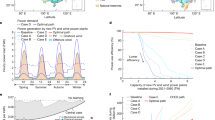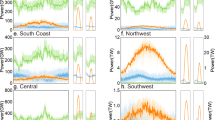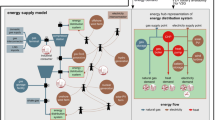Abstract
The design of cost-effective power systems with high shares of variable renewable energy (VRE) technologies requires a modelling approach that simultaneously represents the whole energy system combined with the spatiotemporal and inter-annual variability of VRE. Here, we soft-link a long-term energy system model, which explores new energy system configurations from years to decades, with a high spatial and temporal resolution power system model that captures VRE variability from hours to years. Applying this methodology to Great Britain for 2050, we find that VRE-focused power system design is highly sensitive to the inter-annual variability of weather and that planning based on a single year can lead to operational inadequacy and failure to meet long-term decarbonization objectives. However, some insights do emerge that are relatively stable to weather-year. Reinforcement of the transmission system consistently leads to a decrease in system costs while electricity storage and flexible generation, needed to integrate VRE into the system, are generally deployed close to demand centres.
This is a preview of subscription content, access via your institution
Access options
Access Nature and 54 other Nature Portfolio journals
Get Nature+, our best-value online-access subscription
$29.99 / 30 days
cancel any time
Subscribe to this journal
Receive 12 digital issues and online access to articles
$119.00 per year
only $9.92 per issue
Buy this article
- Purchase on Springer Link
- Instant access to full article PDF
Prices may be subject to local taxes which are calculated during checkout






Similar content being viewed by others
References
Adoption of the Paris Agreement FCCC/CP/2015/L.9/Rev.1 (UNFCCC, 2015); http://unfccc.int/files/essential_background/convention/application/pdf/english_paris_agreemen.
Jacobson, M. Z. Energy modelling: Clean grids with current technology. Nat. Clim. Change 6, 441–442 (2016).
IPCC Renewable Energy Sources and Climate Change Mitigation Special Report of the Intergovernmental Panel on Climate Change (Cambridge Univ. Press, Cambridge, 2011).
Huberty, M. & Zysman, J. An energy system transformation: Framing research choices for the climate challenge. Res. Policy 39, 1027–1029 (2010).
Mitchell, C. Momentum is increasing towards a flexible electricity system based on renewables. Nat. Energy 1, 15030 (2016).
OECD World Energy Outlook 2015 (OECD Publishing, 2015).
Williams, J. H. et al. The technology path to deep greenhouse gas emissions cuts by 2050: the pivotal role of electricity. Science 335, 53–59 (2012).
Freris, L. L. & Infield, D. G. Renewable Energy in Power Systems (John Wiley & Sons, Chichester, 2008).
Fusco, F., Nolan, G. & Ringwood, J. V. Variability reduction through optimal combination of wind/wave resources – An Irish case study. Energy 35, 314–325 (2010).
Elliott, D. A balancing act for renewables. Nat. Energy 1, 15003 (2016).
Braff, W. A., Mueller, J. M. & Trancik, J. E. Value of storage technologies for wind and solar energy. Nat. Clim. Change 6, 964–969 (2016).
Lund, P. D., Lindgren, J., Mikkola, J. & Salpakari, J. Review of energy system flexibility measures to enable high levels of variable renewable electricity. Renew. Sustain. Energy Rev. 45, 785–807 (2015).
Nahmmacher, P., Schmid, E., Hirth, L. & Knopf, B. Carpe diem: A novel approach to select representative days for long-term power system modeling. Energy 112, 430–442 (2016).
Simoes, S. et al. Impact of different levels of geographical disaggregation of wind and PV electricity generation in large energy system models: A case study for Austria. Renew. Energy 105, 183–198 (2017).
Poncelet, K., Delarue, E., Six, D., Duerinck, J. & D’haeseleer, W. Impact of the level of temporal and operational detail in energy-system planning models. Appl. Energy 162, 631–643 (2016).
Nicolosi, M., Mills, A. & Wiser, R. The Importance of High Temporal Resolution in Modeling Renewable Energy Penetration Scenarios (Lawrence Berkeley National Laboratory, 2011); https://pubarchive.lbl.gov/islandora/object/ir:154930/datastream/PDF/…/citation.pdf.
DeCarolis, J. et al. Formalizing best practice for energy system optimization modelling. Appl. Energy 194, 184–198 (2017).
Pina, A., Silva, C. & Ferrão, P. Modeling hourly electricity dynamics for policy making in long-term scenarios. Energy Policy 39, 4692–4702 (2011).
Kannan, R. & Turton, H. A long-term electricity dispatch model with the TIMES framework. Environ. Model Assess. 18, 325–343 (2012).
Ludig, S., Haller, M., Schmid, E. & Bauer, N. Fluctuating renewables in a long-term climate change mitigation strategy. Energy 36, 6674–6685 (2011).
Krakowski, V., Assoumou, E., Mazauric, V. & Maïzi, N. Feasible path toward 40–100% renewable energy shares for power supply in France by 2050: A prospective analysis. Appl. Energy 171, 501–522 (2016).
Merrick, J. H. On representation of temporal variability in electricity capacity planning models. Energy Econ. 59, 261–274 (2016).
Welsch, M. et al. Supporting security and adequacy in future energy systems: The need to enhance long-term energy system models to better treat issues related to variability. Int. J. Energy Res. 39, 377–396 (2015).
Seljom, P. & Tomasgard, A. Short-term uncertainty in long-term energy system models — A case study of wind power in Denmark. Energy Econ. 49, 157–167 (2015).
Deane, J. P., Chiodi, A., Gargiulo, M. & Ó Gallachóir, B. P. Soft-linking of a power systems model to an energy systems model. Energy 42, 303–312 (2012).
Deane, J. P., Gracceva, F., Chiodi, A., Gargiulo, M. & Gallachóir, B. P. Ó. Assessing power system security. A framework and a multi model approach. Int. J. Electr. Power Energy Syst. 73, 283–297 (2015).
Deane, J. P., Gracceva, F., Chiodi, A., Gargiulo, M. & Ó Gallachóir, B. in Informing Energy and Climate Policies Using Energy Systems Models Vol. 30 (eds Giannakidis, G. et al.) 315–331 (Springer, Basel, 2015).
Després, J. Modélisation du Développement à Long Terme du Stockage de l’Électricité dans le Système Énergétique Global. PhD thesis, Univ. Grenoble Alpes (2015).
Hart, E. K. & Jacobson, M. Z. A Monte Carlo approach to generator portfolio planning and carbon emissions assessments of systems with large penetrations of variable renewables. Renew. Energy 36, 2278–2286 (2011).
Gils, H. C. & Simon, S. Carbon neutral archipelago – 100% renewable energy supply for the Canary Islands. Appl. Energy 188, 342–355 (2017).
MacDonald, A. E. et al. Future cost-competitive electricity systems and their impact on US CO2 emissions. Nat. Clim. Change 6, 526–531 (2016).
Frew, B. A., Becker, S., Dvorak, M. J., Andresen, G. B. & Jacobson, M. Z. Flexibility mechanisms and pathways to a highly renewable US electricity future. Energy 101, 65–78 (2016).
Pfenninger, S. & Keirstead, J. Renewables, nuclear, or fossil fuels? Scenarios for Great Britain's power system considering costs, emissions and energy security. Appl. Energy 152, 83–93 (2015).
Mills, A. D. & Wiser, R. H. Strategies to mitigate declines in the economic value of wind and solar at high penetration in California. Appl. Energy 147, 269–278 (2015).
Schmidt, J., Cancella, R. & Pereira, A. O. Jr An optimal mix of solar PV, wind and hydro power for a low-carbon electricity supply in Brazil. Renew. Energy 85, 137–147 (2016).
Nelson, J. et al. High-resolution modeling of the western North American power system demonstrates low-cost and low-carbon futures. Energy Policy 43, 436–447 (2012).
Regional Energy Deployment System (ReEDS) Model Documentation: Version2016 (National Renewable Energy Laboratory, 2016).
Pfenninger, S. Dealing with multiple decades of hourly wind and PV time series in energy models: A comparison of methods to reduce time resolution and the planning implications of inter-annual variability. Appl. Energy 197, 1–13 (2017).
Burtin, A., Silva, V. & EDF Research and Development Division Technical and Economic Analysis of the European Electricity System with 60% RES (EDF R&D, 2015); http://www.energypost.eu/wp-content/uploads/2015/06/EDF-study-for-download-on-EP.pdf.
Artelys, Armines Energies Demain A 100% Renewable Electricity Mix? Analysis and Optimisation- Exploring the Boundaries of Renewable Power Generation in France by 2050 (ADEME, 2016); http://www.ademe.fr/sites/default/files/assets/documents/renewable-electricity-mix-executive-summary-ademe-201601.pdf.
Cox, E. Opening the black box of energy security: A study of conceptions of electricity security in the United Kingdom. Energy Res. Social. Sci. 21, 1–11 (2016).
The Climate Change Act 2008 (Parliament of the United Kingdom, 2008).
Demand Side Response in the Non-Domestic Sector- Final Report for Ofgem (elementenergy & De Montfort University, 2012); http://www.element-energy.co.uk/wordpress/wp-content/uploads/2012/07/Demand-Side-Response-in-the-non-domestic-sector.pdf.
What Is the Potential Availability of DSR? (Sustainability First & elementenergy, 2012); https://www.ofgem.gov.uk/ofgem-publications/56996/sustainability-first-and-element-energy-demand-side-response-event-autumn-2012-pdf.
Schleich, J. & Gruber, E. Beyond case studies: Barriers to energy efficiency in commerce and the services sector. Energy Econ. 30, 449–464 (2008).
Zerrahn, A. & Schill, W.-P. On the representation of demand-side management in power system models. Energy 84, 840–845 (2015).
Long-term Market and Network Constraint Modelling (nationalgrid, 2017); https://www.nationalgrid.com/sites/default/files/documents/Long-term%20Market%20and%20Network%20Constraint%20Modelling.pdf.
Annex C: Reliability Standard Methodology (Department of Energy and Climate Change, 2013); https://www.gov.uk/government/uploads/system/uploads/attachment_data/file/267613/Annex_C_-_reliability_standard_methodology.pdf.
Energy and Climate Change - Second Report, The Future of Britain's Electricity Networks (House of Commons, 2010); https://publications.parliament.uk/pa/cm200910/cmselect/cmenergy/194/19402.htm.
Becker, S. et al. Features of a fully renewable US electricity system: Optimized mixes of wind and solar PV and transmission grid extensions. Energy 72, 443–458 (2014).
Olauson, J. et al. Net load variability in Nordic countries with a highly or fully renewable power system. Nat. Energy 1, 16175 (2016).
Staffell, I. & Pfenninger, S. Using bias-corrected reanalysis to simulate current and future wind power output. Energy 114, 1224–1239 (2016).
Pfenninger, S. & Staffell, I. Long-term patterns of European PV output using 30 years of validated hourly reanalysis and satellite data. Energy 114, 1251–1265 (2016).
Saha, S. et al. The NCEP Climate Forecast System Reanalysis. Bull. Am. Meteor. Soc. 91, 1015–1057 (2010).
Schulz, J. et al. Operational climate monitoring from space: the EUMETSAT Satellite Application Facility on Climate Monitoring (CM-SAF). Atmos. Chem. Phys. 9, 1687–1709 (2009).
Hirth, L. The European Electricity Market Model EMMA Model documentation Version 2017-07-12 (Neon Neue Energieökonomik GmbH, 2017); http://neon-energie.de/EMMA.pdf.
Hirth, L. & Steckel, J. C. The role of capital costs in decarbonizing the electricity sector. Environ. Res. Lett. 11, 114010 (2016).
Hirth, L. The market value of variable renewables: The effect of solar wind power variability on their relative price. Energy Econ. 38, 218–236 (2013).
Lijesen, M. G. The real-time price elasticity of electricity. Energy Econ. 29, 249–258 (2007).
Fais, B., Sabio, N. & Strachan, N. The critical role of the industrial sector in reaching long-term emission reduction, energy efficiency and renewable targets. Appl. Energy 162, 699–712 (2016).
Daly, H. E., Scott, K., Strachan, N. & Barrett, J. Indirect CO2 emission implications of energy system pathways: linking IO and TIMES models for the UK. Environ. Sci. Technol. 49, 10701–10709 (2015).
Fais, B., Keppo, I., Zeyringer, M., Usher, W. & Daly, H. Impact of technology uncertainty on future low-carbon pathways in the UK. Energy Strategy Rev. 13–14, 154–168 (2016).
Zeyringer, M., Fais, B., Keppo, I. & Price, J. The potential of marine energy technologies in the UK – Evaluation from a systems perspective. Renew. Energy 115, 1281–1293 (2018).
Impact Assessment for the Level of the Fifth Carbon Budget (Department of Energy and Climate Change, 2016); http://www.legislation.gov.uk/ukia/2016/152/pdfs/ukia_20160152_en.pdf.
The Fifth Carbon Budget. The Next Step Towards a Low-Carbon Economy (Committee on Climate Change, 2015); https://www.theccc.org.uk/wp-content/uploads/2015/11/Committee-on-Climate-Change-Fifth-Carbon-Budget-Report.pdf.
Loulou, R. & Labriet, M. ETSAP-TIAM: The TIMES integrated assessment model Part I: Model structure. Comput. Manag. Sci. 5, 7–40 (2008).
Pina, A., Silva, C. A. & Ferrão, P. High-resolution modeling framework for planning electricity systems with high penetration of renewables. Appl. Energy 112, 215–223 (2013).
Plant Capacity: United Kingdom (DUKES 5.7) (National Statistics, 2017; accessed 20 February 2018); https://www.gov.uk/government/statistics/electricity-chapter-5-digest-of-united-kingdom-energy-statistics-dukes.
Capacity of, and Electricity Generated from, Renewable Sources (DUKES 6.4) (National Statistics, 2017; accessed: 20 February 2018); https://www.gov.uk/government/statistics/renewable-sources-of-energy-chapter-6-digest-of-united-kingdom-energy-statistics-dukes.
Power Stations in the United Kingdom (DUKES 5.11) (National Statistics, 2017; accessed 20 February 2018); https://www.gov.uk/government/statistics/electricity-chapter-5-digest-of-united-kingdom-energy-statistics-dukes.
Electricity: Commodity Balances (DUKES 5.1) (National Statistics, 2016); https://www.gov.uk/government/statistics/electricity-chapter-5-digest-of-united-kingdom-energy-statistics-dukes.
Digest of UK Energy Statistics (DUKES) Chapter 5: Electricity. (National Statistics, 2017); https://www.gov.uk/government/uploads/system/uploads/attachment_data/file/633779/Chapter_5.pdf.
Miranda, M. S. & Dunn, R. W. Spatially correlated wind speed modelling for generation adequacy studies in the UK. In IEEE Power Engineering Society General Meeting 1–6 (2007).
Acknowledgements
This research was supported under the Whole Systems Energy Modelling Consortium (WholeSEM) – Ref: EP/K039326/1. We would like to thank D. Brayshaw for his comments at the wholeSEM conference that have improved our analysis, N. Strachan for his comments on an earlier draft and A. Moore for fruitful discussions.
Author information
Authors and Affiliations
Contributions
M.Z. designed the study with J.P. M.Z. and J.P. developed the highRES model. B.F. co-built the UKTM model. M.Z. and J.P conducted the highRES model runs. B.F. and P.-H.L. conducted the UKTM model runs. M.Z. conducted the spatial analysis on the capacity potential per technology, E.S. generated the wind time series; J.P. generated the PV time series. B.F. wrote the text on UKTM; E.S. wrote the text on generating wind time series. M.Z. wrote the document with J.P. and they generated figures and tables.
Corresponding author
Ethics declarations
Competing interests
The authors declare no competing interests.
Additional information
Publisher’s note: Springer Nature remains neutral with regard to jurisdictional claims in published maps and institutional affiliations.
Supplementary information
Supplementary Information
Supplementary Notes 1–12, Supplementary Figures 1–32, Supplementary Tables 1–9 and Supplementary References
Rights and permissions
About this article
Cite this article
Zeyringer, M., Price, J., Fais, B. et al. Designing low-carbon power systems for Great Britain in 2050 that are robust to the spatiotemporal and inter-annual variability of weather. Nat Energy 3, 395–403 (2018). https://doi.org/10.1038/s41560-018-0128-x
Received:
Accepted:
Published:
Issue Date:
DOI: https://doi.org/10.1038/s41560-018-0128-x
This article is cited by
-
Identification of weather patterns and transitions likely to cause power outages in the United Kingdom
Communications Earth & Environment (2024)
-
The error induced by using representative periods in capacity expansion models: system cost, total capacity mix and regional capacity mix
Energy Systems (2024)
-
A synthetic dataset of Danish residential electricity prosumers
Scientific Data (2023)
-
The impact of methane leakage on the role of natural gas in the European energy transition
Nature Communications (2023)
-
Energy storage solutions to decarbonize electricity through enhanced capacity expansion modelling
Nature Energy (2023)



